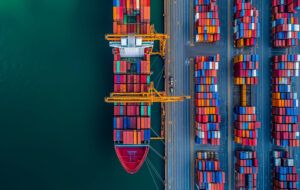
Blog
Years of Inaction Contributed to Today’s Supply Chain Crisis. (And It’s More Than Ports.)
Last week, there were 87 cargo ships off the coast of California queued to unload at the ports of Los Angeles and Long Beach. This cargo flotilla is a manifestation of a supply chain that, until the COVID-19 pandemic, was largely invisible to most Americans. Now, as costs spike and warnings of holiday shortages loom, the strained supply chain is kitchen table conversation.
What isn’t discussed at kitchen tables — or anywhere else for that matter — is that opportunities to streamline the supply chain have been overlooked by policymakers for decades. Up until the Biden administration’s recent engagement on ports, supply chain has been out of sight, out of mind in Washington too.
What isn’t discussed at kitchen tables — or anywhere else for that matter — is that opportunities to streamline the supply chain have been overlooked by policymakers for decades.
Trucking capacity issues have long plagued the supply chain but no substantive action has been taken. The lack of competition for maritime and rail shipping has been exacerbated by a lack of oversight or interest — or both. A $9.3 billion harbor maintenance trust fund surplus is being wasted due to inflexibility in port funding. There was no action on the recommendations in the Federal Maritime Commission’s 2017 innovation report. And, despite months negotiating the bipartisan infrastructure package that passed in the Senate, the bill is stalled in the House, falling victim to political gamesmanship.
It is decades of this same gamesmanship — or disinterest — that has contributed to today’s supply chain problems.
The consumer packaged goods industry — makers of food, beverage, cleaning and personal care products — has reached its limit. There is no slack left in their systems at a time when they confront unrelenting demand. That demand has only grown since the start of the pandemic, up 8.7% in the second quarter over last year (yes, even over the panic buying that cleared shelves at the outset of COVID-19).
People can endure furniture delays or wait longer for exercise equipment, but they cannot wait for baby formula, toilet paper or, as we’ve seen recently, school lunches. A supply chain in crisis refuses to be ignored. It is showing up as higher costs for manufacturers and, ultimately, consumers. But higher prices are an indication of a supply and demand imbalance — an imbalance that can quickly tip into a lack of availability. Today, that means fewer choices on the store shelf; left unaddressed, the consequences could be much more severe.
People can endure furniture delays or wait longer for exercise equipment, but they cannot wait for baby formula or toilet paper.
The supply chain is crying out for Washington policymakers’ attention and engagement. This month I joined a White House meeting on the supply chain crisis. While there was significant focus on the ports, it is imperative that we remember that supply chain bottlenecks are not only at our shorelines. As discussions continue, our industry would like to see greater action in three key areas:
1. Increasing the labor pool. Higher prices and supply chain bottlenecks are symptoms of the labor shortage in the U.S. Every effort to fill jobs in supply chains must be considered, including financial incentives to recruit truck drivers, temporary visas to fill employment gaps and, if needed, targeted use of the National Guard to relieve significant supply chain choke points.
2. Maintaining regulatory flexibility. In response to COVID-19, regulatory flexibility was allowed and must be extended until the pandemic recedes and the supply chain catches up. Whether it’s action to increase trucking capacity — like with Hours of Service flexibility or easing truck weight restrictions — or pausing planned rollbacks of flexibility like the EPA has proposed with disinfectants, the government must take a “do no harm” position right now that allows companies to focus on delivering for consumers.
3. Establishing a supply chain war room. Regularly bringing private sector experts and government leaders together will help rapidly identify problems and activate solutions, as changes to the ports hours exemplify.
Much more must happen for long-term supply chain health, infrastructure improvements first and foremost. But there are things that can’t wait. Chalking these challenges up as transitory is the equivalent of a shoulder shrug. That kind of ambivalence got us here. It will also get us into deeper trouble if it continues.
Published on October 22, 2021




